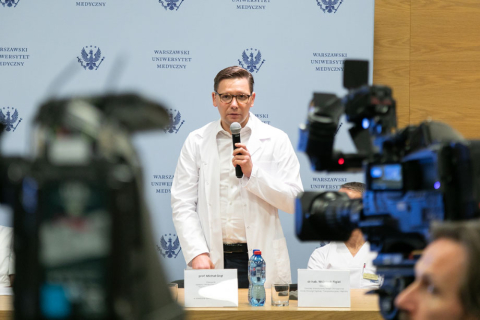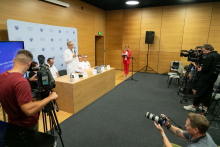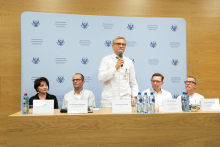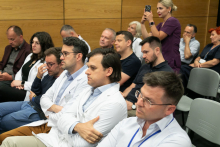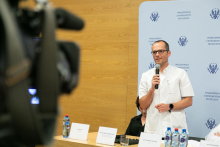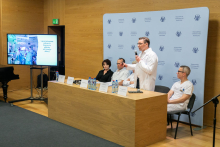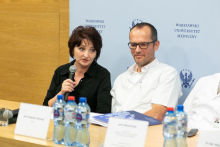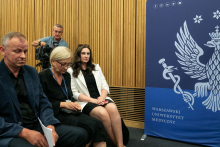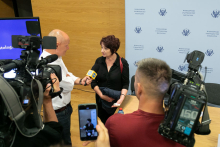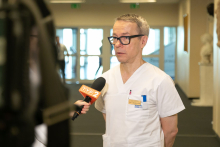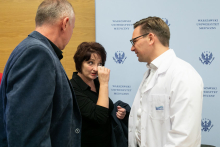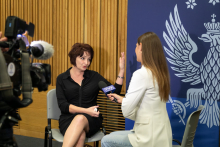The procedure was performed on May 31, 2024, and lasted about seven hours. A press conference dedicated to it was held on July 4 at MUW. The speakers were Prof. Zbigniew Gaciong, Rector of MUW, Prof. Michal Grąt, Head of the Chair and Department of General, Transplant and Liver Surgery UCC MUW, Adam Przybyłkowski, MD, PhD, deputy director for Treatment at Banacha Location UCC MUW, Wojciech Figiel, MD, PhD, Head of the Surgical Intensive Care Unit of the Department of General, Transplant and Liver Surgery UCC MUW, and Ms. Aldona, the patient who underwent the innovative procedure.
During the conference, Professor Zbigniew Gaciong reminded that the organ transplantation program is a very important area of our university's activities.
- The organ transplantation program began in 1966 at our university, when the first transplantation in Poland was performed, and has continued to this day. In the last few years it has received a remarkable acceleration - not only in terms of the number of organs transplanted, but also in terms of enrichment with new procedures - heart transplantation, heart transplantation in children, lung transplantation. On the other hand, the Liver Transplant Program at the moment is in the first place in terms of both quantitative and qualitative results, for example, in the number of organs transplanted from deceased donors we are probably the number 1 center in the world - the Rector stressed.
A very important guest of the conference was Mrs. Aldona. She came to the conference under the care of her husband but on her own. Asked how she felt, she replied:
- Today I feel very good. "On the liver side" I function the same as before the accident. No dietary restrictions are needed. Of course, my body is still battered, I have my infirmities, which I still have to fight, and rehabilitation is needed to get me back to my balance and former activity.
What the breakthrough was about
What the procedure consisted of and its innovation was explained by Prof. Grąt at the conference. The professor and his team undertook, as the first in the world, to remove only a part of the liver damaged in a traffic accident, leaving an undamaged part of it, and to implant a small liver fragment taken from a deceased donor in place of the removed right lobe.
- The patient's liver was severely damaged as a result of a traffic accident, so we had to remove most of the organ. Unfortunately, the remaining fragment was too small for the patient to survive. We wanted to save the patient, of course, but we also wanted to make her leave the hospital with her own healthy liver, without the need for immunosuppressive treatment for the rest of her life. We decided to perform a world-pioneering supportive transplantation of a liver damaged in a traffic accident, and at the same time the first use of supportive liver transplantation in Poland - said Prof. Michal Grąt.
Challenges of the innovative operation
The biggest challenge for the transplantologists was to perform surgery to remove the liver fragment, which was massively damaged, and to take a small liver fragment from the deceased donor while preserving the bile outflow, relevant arterial, portal vessels and venous system so that it could be anastomosed to the recipient's appropriate vessels and bile ducts.
Another challenge was implanting the liver fragment “upside down.” The implanted fragment had to be reversed because the left part of the liver was taken and implanted in place of the much larger right segments, meaning that the order of the anastomoses and the arrangement of all the vessels were completely different. Performing all anastomoses “upside down” was crucial for the implanted fragment to function after transplantation.
The team aimed to ensure that the transplanted organ fragment did not function “too well,” as it would begin to outgrow more than the patient's liver fragment remaining.
- This would have led to a situation in which the implanted fragment could no longer be removed and the patient would have had to take the immunosuppressive treatment necessary after the transplant. So we had to calibrate the diameter of the anastomosis so that the main part of the blood would go to the patient's liver fragment and not to the transplanted fragment - explained Prof. Michal Grąt.
The effects of the treatment exceeded expectations
When embarking on the procedure, transplantologists assumed that transplanting a small piece of the liver would allow the patient to survive one to two weeks after surgery, during which time her liver would regenerate.
- All our efforts were focused on preserving at least a fragment of the liver in our patient, so as to “give it a chance” to outgrow (which is a desirable development) and allow the patient to survive - Prof. Grąt said.
Meanwhile, one week after the transplant, the patient was found to have nearly threefold hypertrophy of her own liver. Therefore, on the 11th day after the first operation, the decision was made to perform a second procedure - removing part of the liver from the deceased donor. Transplantologists achieved the desired goal: the patient left the hospital with her own healthy liver, does not require immunosuppressive treatment and did not develop significant complications.
New possibilities for transplantologists and new opportunities for patients
Given the very good effect of supportive liver transplantation in a patient after a traffic accident, transplantologists at the Department of General, Transplant and Liver Surgery UCC MUW plan to perform such transplants also in patients with acute liver failure and selected liver tumors.
This transplantation has also opened up new possibilities for transplants using organs from living donors in adults. Until now, such small liver fragments were donated to the Children's Health Center, where they were implanted in children. The supportive liver transplantation carried out by Prof. Grąt's team proves that even a small liver fragment - including from a living donor - can be used in a supportive system in an adult. For patients with acute liver failure, such a fragment gives the liver time to regenerate and take up all its functions. In addition, taking a small fragment from a living donor significantly reduces the risk of complications in the donor.
- Due to the fact that we are a large transplant center, we knew that if the transplant failed and the patient developed liver failure, we would immediately qualify her for a whole liver transplant. However, we believed that the operation would be successful. The Split Liver Transplant Program, introduced last year, prepared us to perform such a procedure. Thanks to it, we gained experience in dividing the liver, in implanting it properly and in preparing the recipient for this transplantation. We used all this experience in transplanting this small liver fragment in a patient after a traffic accident - says Prof. Michał Grąt.
The surgical team
Transplantation surgeon: Prof. Michał Grąt, assisted by Dr. Wacław Hołówko, Dr. Andriy Zhylko
Division of the harvested liver from a deceased donor: Dr. Konrad Kobryn, Dr. Paweł Rykowski
Liver donation from deceased donor: Dr. Łukasz Nazarewski, Dr. Oleksandra Ostapiak, nurse Joanna Rzadkiewicz
Anesthesiologist: Dr. Paula Dudek
Nursing team: Anna Wąsik (circulating nurse), Grzegorz Nowakowski (circulating nurse), Paulina Piętka (anesthetist), Piotr Wesołowski (anesthetist)
Transplant coordinator: Krzysztof Zając, MA.
The press conference was led by Marta Wojtach, director of communications, spokeswoman for MUW
